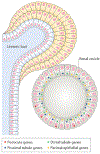Single-cell RNA sequencing for the study of development, physiology and disease
- PMID: 29789704
- PMCID: PMC6070143
- DOI: 10.1038/s41581-018-0021-7
Single-cell RNA sequencing for the study of development, physiology and disease
Abstract
An ongoing technological revolution is continually improving our ability to carry out very high-resolution studies of gene expression patterns. Current technology enables the global gene expression profiles of single cells to be defined, facilitating dissection of heterogeneity in cell populations that was previously hidden. In contrast to gene expression studies that use bulk RNA samples and provide only a virtual average of the diverse constituent cells, single-cell studies enable the molecular distinction of all cell types within a complex population mix, such as a tumour or developing organ. For instance, single-cell gene expression profiling has contributed to improved understanding of how histologically identical, adjacent cells make different differentiation decisions during development. Beyond development, single-cell gene expression studies have enabled the characteristics of previously known cell types to be more fully defined and facilitated the identification of novel categories of cells, contributing to improvements in our understanding of both normal and disease-related physiological processes and leading to the identification of new treatment approaches. Although limitations remain to be overcome, technology for the analysis of single-cell gene expression patterns is improving rapidly and beginning to provide a detailed atlas of the gene expression patterns of all cell types in the human body.
Conflict of interest statement
Competing interests
The author declares no competing interests.
Figures






References
-
- Li H et al. Reference component analysis of single- cell transcriptomes elucidates cellular heterogeneity in human colorectal tumors. Nat. Genet 49, 708–718 (2017). - PubMed
Publication types
MeSH terms
Grants and funding
LinkOut - more resources
Full Text Sources
Other Literature Sources
Medical

